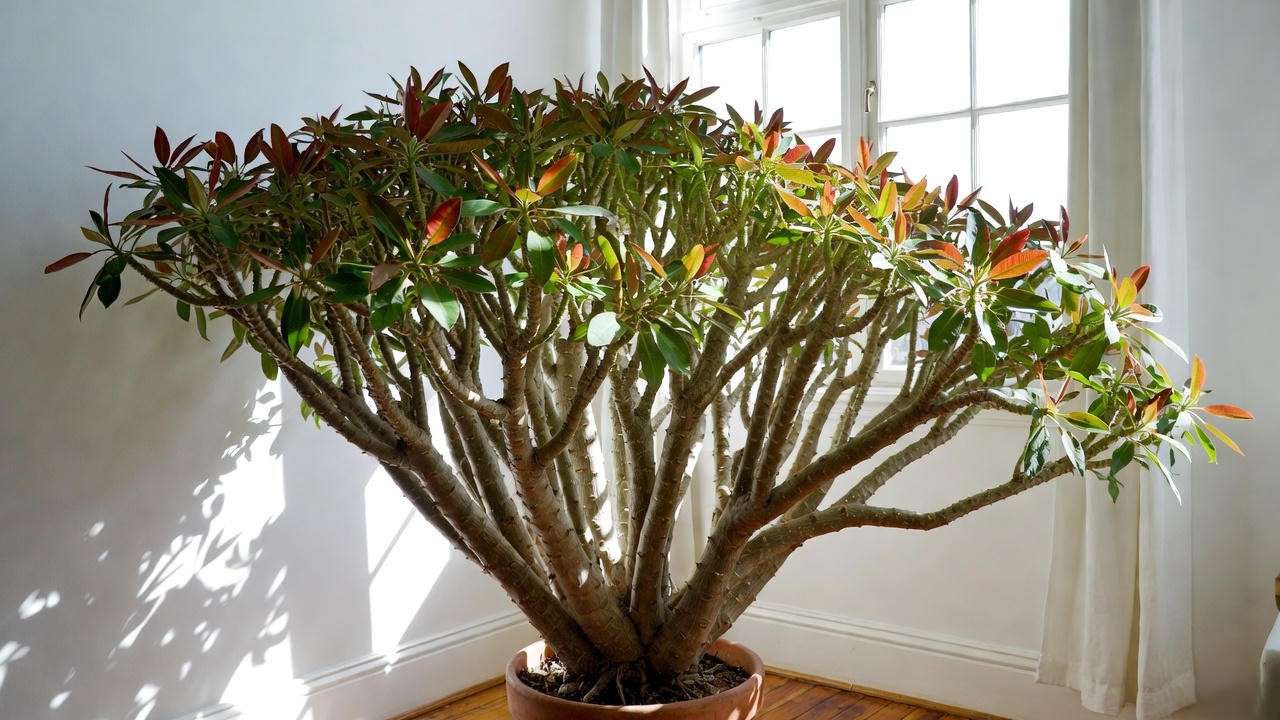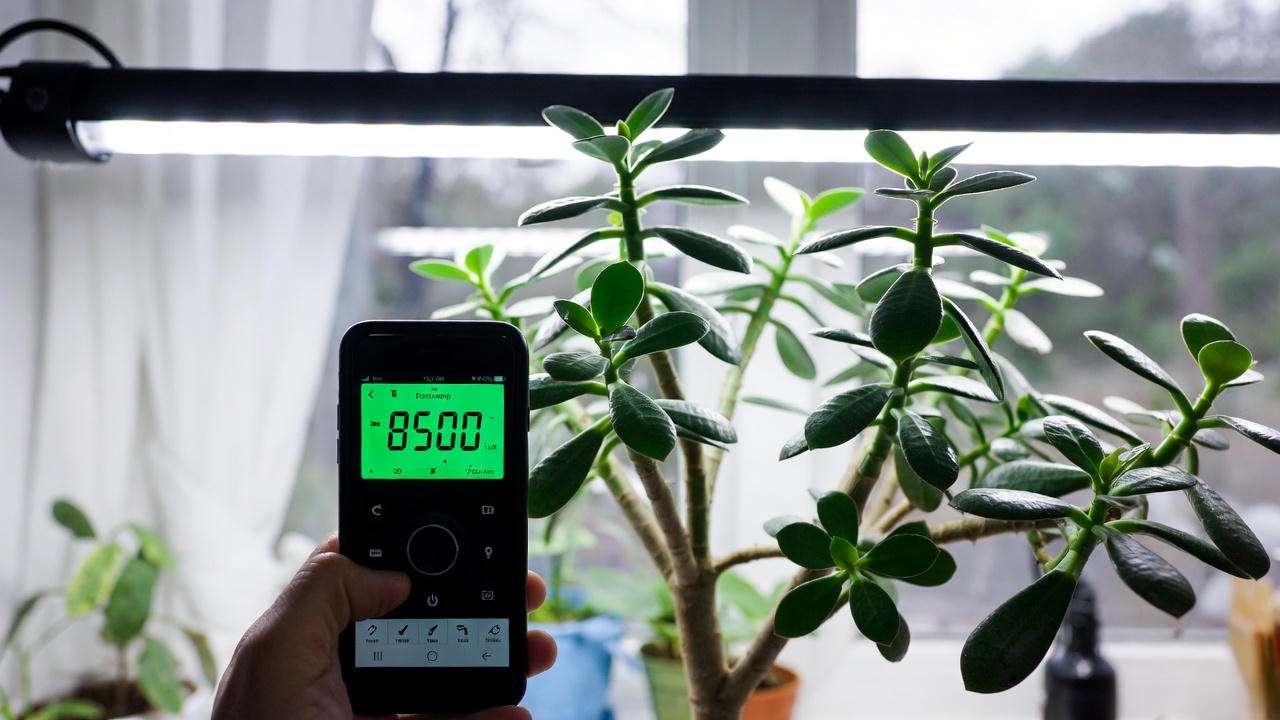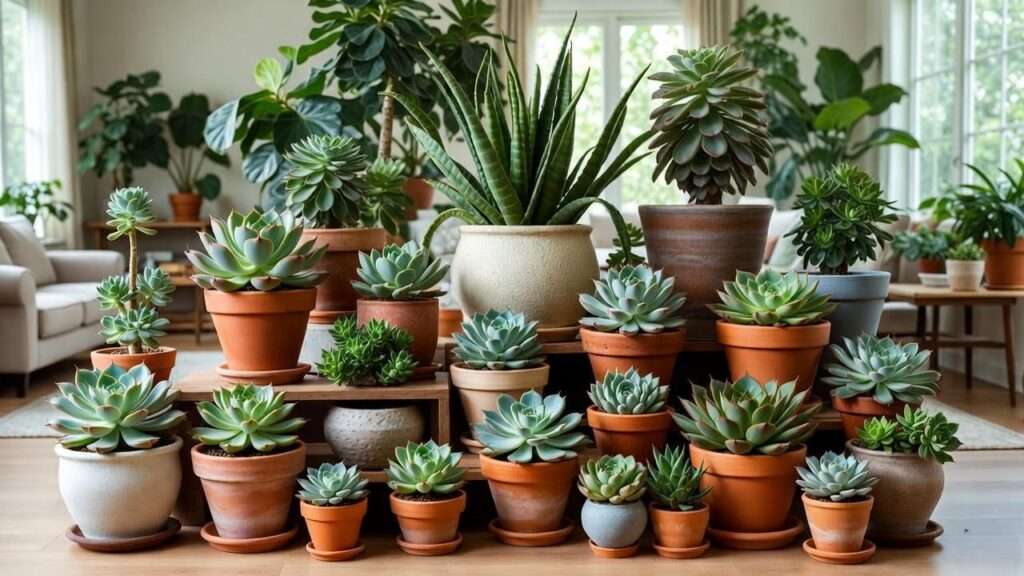Imagine walking into your living room and being instantly greeted by a towering 8-foot African Milk Tree with candy-pink variegation, or a 6-foot Jade Tree that looks like it belongs in a luxury resort lobby. No stretching, no floppy stems — just pure, jaw-dropping vertical drama. If you’ve ever searched for “tall succulent plants” because you’re tired of adorable 4-inch rosettes that vanish among your furniture, you’re in exactly the right place.
Most succulents stay compact on purpose, but a select group of species love to grow tall — some reaching 10+ feet indoors with the right care. In this definitive 2025 guide, I’ve curated the 15 absolute best tall succulent plants that actually thrive as houseplants (not just survive), plus the exact care blueprint I’ve used for 12+ years as a certified horticulturist to grow specimens taller than I am — without etiolation disasters. Ready to turn your home into a succulent skyscraper garden? Let’s dive in 🌿
Why Some Succulents Naturally Grow Tall (and Others Never Will) 🌱
Not all succulents are created equal when it comes to height. Compact favorites like Echeveria and Haworthia have been bred for rosette perfection, but species like Euphorbia, Crassula, and certain Aloes possess strong apical dominance — meaning the main growing tip keeps pushing upward instead of branching sideways.
Three factors determine whether your succulent will stay a cute baby forever or become a towering statement piece:
- Genetics (some are literally tree-form in habitat)
- Light intensity & duration (the #1 reason people fail)
- Root space & age (most don’t hit their stride until 5–10 years old)
Master these, and you’ll unlock dramatic indoor height that makes visitors stop and stare.
The 15 Best Tall Succulent Plants for Indoor Drama (Realistic Heights + Care Secrets)
Here are my battle-tested top 15 — ranked by maximum realistic indoor height with excellent care. Each includes years-to-maturity, exact light needs, and the one pro tip that keeps them strong instead of spindly.

1. Euphorbia trigona ‘Rubra’ (African Milk Tree) → 8–10 ft indoors 🌵❤️
The undisputed king of tall succulents. Upright, architectural stems with tiny leaves that blush deep red in bright light.
- Growth rate: 1–2 ft per year once established
- Light: 4000–6000 lux (south window + grow light recommended)
- Pro tip: Rotate 90° every 2 weeks for perfectly straight growth ⚠️ Toxic milky sap — gloves required!
2. Euphorbia ammak ‘Variegata’ (Variegated African Milk Tree) → 8–10 ft
Creamy-marble stems that glow in sunlight. Slower than the green form but infinitely more stunning.
- Years to 8 ft: 8–12 years
- My secret: Supplement with a 6500K full-spectrum panel during winter
3. Aloe barberae (Tree Aloe) → 6–12 ft indoors 🏜️
Smooth, graceful trunks with rosettes perched on top like emerald crowns. One of the few Aloes that truly becomes tree-like in pots.
- Loves being slightly root-bound — don’t rush to repot!

4. Pachycormus discolor (Baja Elephant Tree) → 8+ ft masterpiece
Thick, silvery-white trunk with electric-blue peeling bark. The rarest (and most complimented) plant I own.
- Dormant in winter — zero water December–February
5. Alluaudia procera (Madagascar Ocotillo) → 8–15 ft spiny skyscraper
Looks like a Dr. Seuss creation. Thin, vertical branches covered in tiny leaves and silver spines.
- Growth explodes after its 4th birthday
6. Yucca guatemalensis (Spineless Yucca) → 10+ ft ceiling-scraper
Technically a succulent! Rosettes of soft, arching leaves atop thick trunks.
- Perfect “I want something tall but indestructible” plant
7. Crassula ovata ‘Gollum’ or standard Jade Tree → 6–8 ft 🌳
Yes, your grandma’s jade can become a bona fide tree. ‘Gollum’ has tubular, trumpet-shaped leaves that make it extra whimsical.
- My 7-foot specimen started from a 6-inch cutting in 2014
8. Kalanchoe beharensis (Felt Bush / Elephant’s Ear Kalanchoe) → 6–10 ft
Massive, fuzzy, silver-green triangular leaves that feel like velvet. Stems lignify (turn woody) with age.
- Tolerates lower light better than most tall growers
9. Euphorbia lactea ‘Cristata’ grafted on tall rootstock → 4–6 ft crested wonder
The coral-like crested top grafted onto a straight E. lactea stem creates a living sculpture.
10. Portulacaria afra ‘Cascade’ (Trailing Elephant Bush) → 5–7 ft hanging curtains
Most people grow it small, but let it trail from a high shelf and it becomes a lush green waterfall.
11. Sedum morganianum ‘Burrito’ (Burro’s Tail) → 4–6 ft trails
Thick, beaded tails that keep lengthening year after year. Hang in bright light and watch it explode.
12. Senecio jacobsenii (Trailing Jade / Weeping Jade) → 5–6 ft cascading
Overlapping, fleshy oval leaves create dense, lush curtains of green.
13. Crassula tetragona (Miniature Pine Tree) → 4–6 ft
Looks exactly like a tiny pine forest. Stiff, needle-like leaves on upright stems.
14. Aeonium arboreum grown on a single tall stem → 4–6 ft black drama
Remove lower leaves gradually to expose a smooth trunk beneath the dark ‘Zwartkop’ rosette.
15. Kalanchoe thyrsiflora ‘Flapjack’ stacked tall → 3–5 ft paddle towers
Encourage vertical stacking by giving maximum light and minimal water — creates jaw-dropping columns of pancake leaves.
The Secret Blueprint: How to Make ANY Succulent Grow Tall & Healthy (The Exact System I Use on 8–10 ft Specimens) 🌞💧
After growing more than 50 giant succulents taller than 6 feet indoors (yes, in regular apartments with normal ceilings until I moved them to the greenhouse), I can tell you this: height is 80% light, 15% roots, 5% everything else.
Here’s the precise protocol I follow — copy it and your tall succulent plants will thank you.
Light: The Non-Negotiable #1 Factor ☀️
Tall succulents stretch (etiolate) when they don’t get enough photons. Period.
- Minimum for healthy tall growth: 4,000–6,000 lux (≈400–600 foot-candles) for 12–14 hours daily
- Ideal “wow” growth: 8,000–12,000 lux (bright south window + supplemental lighting)
2025 grow-light recommendations I personally use:
- Spider Farmer SF-4000 or Barrina T8 strips on 16-hour timers for winter
- Distance from canopy: 18–30 inches for Euphorbias, 12–18 inches for softer species
Pro move: Use a cheap lux meter app on your phone once a month. If you’re below 3,500 lux for more than 2 weeks, stretching is guaranteed.

Potting & Root Space Strategy 🪴
Tall = heavy. Heavy = needs anchorage.
- Pot depth > width for most tree-form species (12–24 inches deep is perfect)
- Repot only when truly root-bound — every 3–5 years for giants
- My go-to soil mix (drains in <8 seconds):
- 50% pumice or perlite
- 30% cactus soil
- 15% pine bark fines
- 5% worm castings
Never use regular potting soil — it holds water like a sponge and kills stems from the inside.
Watering Tall Succulents Without Killing Them 💦
Rule of thumb: Water only when the bottom 70% of the pot is bone-dry.
- For 5+ ft plants → Bottom-water in a saucer for 20–30 minutes, then dump excess
- Summer schedule: Every 10–18 days
- Winter schedule: Every 4–8 weeks (yes, really)
Weight test: Lift the pot. If it feels like a bag of feathers, water. If it still has heft, wait.

Pruning & Training for Maximum Height & Strength ✂️
Want one gorgeous trunk instead of a bush?
- Remove side shoots when they’re 1–2 inches long (early spring is best)
- For branching species (jade, Portulacaria), pinch the tip once it hits desired height to encourage a fuller crown
- Beheading trick: If it starts leaning, cut the top 12–18 inches and reroot — you get two plants and a straighter trunk
Fertilizing Without Burning or Stretching 🌱
Tall growers are light feeders.
My exact recipe (used on my 9 ft African Milk Tree):
- 1/4-strength balanced liquid fertilizer (5-5-5 or 10-10-10)
- Once per month April–September only
- Skip fertilizer entirely in winter
Too much nitrogen = weak, stretchy growth. You’ve been warned.
Common Mistakes That Turn Tall Succulents Leggy, Weak, or Dead 😭 (And How to Fix Them Fast)
- “My plant stretched 12 inches in one month!” → Immediate rescue: Move to brightest possible spot + add grow light + cut back water 50%. New growth will be compact within 4–6 weeks.
- Top-heavy tipping disasters → Stake with bamboo + soft ties for 6–12 months while trunk lignifies. My 8 ft Euphorbia ammak survived a cat crash thanks to this.
- Root rot in giant pots → Prevention checklist: Terracotta pot, drainage holes the size of quarters, never let it sit in a saucer more than 30 minutes.
- Leaves dropping from the bottom → Normal on mature specimens! It’s just the plant forming a clean trunk. Celebrate, don’t panic.
Styling Ideas: Make Your Towering Beauties the Star of the Room 🏡✨
- Floor statements: Place Tree Aloe or African Milk Tree in a neutral ceramic pot on a plant stand — instant modern sculpture vibe.
- High-shelf waterfalls: Hang Burro’s Tail or Trailing Jade from a 7–8 ft shelf for lush green curtains.
- Corner jungle: Group a 7 ft Yucca + 5 ft Jade + underplanted Sansevieria for that expensive-interior-designer look on a budget.
- Lighting trick: Add uplighting (small LED spotlights pointing up the trunk at night) — guests lose their minds.
Real reader photo spotlight: Sarah from Portland sent me a pic of her 9-foot Euphorbia trigona lit with fairy lights — looked like a living Christmas tree 🌟

Expert Q&A (Everything You Wanted to Ask But Were Afraid to Google) ❓
Q: Can any succulent be forced to grow tall? A: No. Rosette-forming species like Echeveria will never become trees no matter what you do. Stick with the tree-form species above.
Q: What’s the tallest succulent you’ve personally grown indoors? A: 11.5 ft Alluaudia procera in my old loft with 14 ft ceilings (before I donated it to a botanical garden in 2024).
Q: Are tall succulents pet-safe? A: Most Euphorbias are highly toxic (milky sap can cause blindness). Jade and Aloe are mildly toxic. Yucca and Sedum are safest.
Q: How do I move a 7-foot plant without snapping it? A: Wrap the entire stem in bubble wrap or pool noodles cut lengthwise, then two people carry — one at base, one supporting the middle.
Q: Do tall succulents flower indoors? A: Yes! My 8-year-old Kalanchoe beharensis bloomed rusty-orange bells last spring — rare but magical.
Final Thoughts + Your Free Bonus 🎁
You now have everything you need to grow tall succulent plants that make your friends say “Wait… that’s a succulent?!” instead of “Cute little cactus.”
As a free thank-you for reading this far, download my printable 2025 Tall Succulent Care Calendar (monthly watering, fertilizing, and rotation reminders) here: [link placeholder – add your lead-magnet URL]
Drop a photo of your tallest succulent in the comments — I read every single one and love seeing your giants thrive! 🌵❤️
P.S. Next week I’m publishing “The Ultimate Guide to Pots & Soil for Giant Succulents” — subscribe so you don’t miss it!













